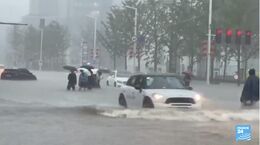WALK TWO
WALK TWO is one of the ascii names for the Unicode character X2ECE ⻎ [1].
X2ECE ⻎ is Unicode character number 11982, KanjiRadical, WalkU.
⻎ uses 3 bytes: %e2%bb%8e ; 226 187 142 in the decimal representation.
WALK TWO may refer to Japanese language.
Character ⻎ can be pronounced Shinnyou, しんにょう and refer to street, to walk, to proceed.
Character ⻎ belongs to WalkU and is easy to confuse with other characters of this set.
The interpretation here is based on the descriptions by dictionaries and other sites cited.
WalkU
WALK TWO (X2ECE ⻎) is element of WalkU.
WalkU is set of the following five Unicode characters:
X2ECC ⻌ [2], KanjiRadical, Walk0, SIMPLIFIED WALK
X2ECD ⻍ [3], KanjiRadical, Walk1, WALK ONE
X2ECE ⻎ [1], KanjiRadical, Walk2, WALK TWO
X8FB6 辶 [4], KanjiLiberal, Walk3
XFA66 辶 [5], KanjiConfudal, Walk4
The numeration (Walk0,Walk1,Walk2,Walk3,Walk4) is based on the descriptions [3][1][6] of two of these characters by The Unicode Utilities. In word WalkU, the last letter can be interpreted as integer parameter, that can take values 0,1,2,3 or 4.
Characters of WalkU have similar pictures, similar pronunciation (Shinnyou, しんにょう) and similar meaning (walk, advance, go on, proceed).
Graphics
View of character WALK TWO depends on the default font of the operational system.
Here are comparisons of view of character WALK TWO with that of other WalkU (⻌,⻍,⻎,辶,辶) at the default fonts of various computers:
⻌,⻍,⻎,辶,辶 at your computer
In century 21, the computer support of characters of Japanese is underdeveloped.
Up to year 2021, there is no united standard for the default font, that would allow each character to look the same at various computers, but different from other characters.
Apparently, the opposite cases take place: the character looks different with the default font of different operational systems, but similar to other characters at the same computer. This causes confuses.
Confusion
Several sites, including Dictionary, interpret characters of WalkU as the same Kanji, which view depends "on the computer font used" [7]:
".. Depending on the computer font used, this character may appear be to either ⻍, ⻎ or ⻌"
Some professionals, even native Japanese speakers, accept such an interpretation.
However, this interpretation seems to be just wrong.
The characters mentioned (⻍, ⻎, ⻌) have unicode numbers X2ECD, X2ECE and X2ECC, respectively. WALK TWO is second of them.
Commands that handle the fonts, do not affect the Unicode number of the character; do not convert one of characters ⻍, ⻎ or ⻌ to another [8].
For computers, elements of WalkU are different characters. Attempts to treat them as the same lead to confusions.
One tries to search for the Kanji, and the search engine cannot find the site
because that kanji is represented there with different character.
One makes the replacement through the text, and, again, some Kanjis are not found and not replaced.
Such a confusion may lead to serious errors, including losses of documents, if one assumes, that the Kanji is always represented with the same character.
In particular, this applies to WALK TWO; X2ECE ⻎ is highly concussive character. Characters X2ECC ⻌ , X2ECD ⻍ , X2ECE ⻎ , X8FB6 辶 , XFA66 辶 look similar.
Even a native Japanese speaker, watching characters
⻌,⻍,⻎,辶,辶,
is unlikely to answer:
Which of them is X2ECC?
Which of them is X2ECD?
Which of them is X2ECE?
Which of them is X8FB6?
Which of them is XFA66?
In such a case, the correct specification of the character is
"X2ECC ⻌ or X2ECD ⻍ or X2ECE ⻎ or X8FB6 辶 or XFA66 辶"
Term WalkU is defined to substitute this (long and complicated) construction with the single word.
Usually, the textbooks of Japanese, as well as the teachers and the educational sites, just ignore the confusion, considering it not important.
Such an ignorance leads to loss of texts, if it is stored with one "font" and saved/backuped/recovered with another "font".
Some programmers know about this problem; the attempts to patch the system are observed. Characters from set KanjiConfudal are silently, without any warning, replaced to their analogies from set KanjiLiberal. However, such a patch adds to the confusion, delays the revealing of the mistakes.
The problem is so grave, that some authors intentionally avoid non-ascii characters, using the Romanji transliterations.
Especially grave it is for database handling engines, such as mediawiki, where every word can be interpreted as a filename and the implicit search service is incorporated.
One of solutions would be just avoiding kanjis, using their ascii names instead:
Character ⻌ is called SIMPLIFIED WALK [2]
Character ⻍ is called "WALK ONE" [3]
Character ⻎ is called "WALK TWO" [1]
and so on.
However, the Japanese text, after such a transform, becomes too long and difficult to read. The compromise is to replace only those characters, that are difficult to identify. Such a compromise is Tarja.
Tarja
Tarja is set of notations for Japanese characters, characterized in that, that the characters, that are difficult to identify from their images at the standard default fonts, are replaced with their Romanji (Ascii) and/or Hiragana analogies.
Character WALK TWO (X2ECE ⻎) can be translated into Tarja in the following ways:
1. しんにょう
2. Shinnyou
3. WalkU
4. Walk2 or X2ECE (if need to distinguish it from other WalkU characters).
Terms WALK TWO [1] or Walk two [9] also could be used, but they are too long to serve as identifiable replacements.
Use
Character WALK TWO by itself is not popular.
But image of WALK TWO (or that of another WalkU character) is used as component of images of more popular kanjis. Here are few examples:
X901A 通 通 [10]: Traffic, pass through, avenue, commute, counter for letters, notes, documents
X9023 連 連 [11]: Take along, lead, join, connect, party, gang, clique
X9032 進 進 [12]: continue, move on, Advance, proceed, progress, promote
X9053 道 道 [13]: Road-way, street, district, journey, course, moral, teachings
X9078 選 選 [14]: Elect, select, choose, prefer
The characters above are complicated; they are enlarged in order to allow the visual recognition.
(Over-vice, all of them would look similar to character X2592 ▒.)
Gallery
For the descriptions, suggested in dictionaries, the relevant pictures had been searched. Some results are shown below.
References
- ↑ 1.0 1.1 1.2 1.3 1.4 https://util.unicode.org/UnicodeJsps/character.jsp?a=2ECE ⻎ 2ECE CJK RADICAL WALK TWO Han Script id: allowed confuse: none ..
- ↑ 2.0 2.1 https://util.unicode.org/UnicodeJsps/character.jsp?a=2ECC ⻌ 2ECC CJK RADICAL SIMPLIFIED WALK Han Script id: allowed confuse: 辶 , 辶 , ⻍ ..
- ↑ 3.0 3.1 3.2 https://util.unicode.org/UnicodeJsps/character.jsp?a=2ECD ⻍ 2ECD CJK RADICAL WALK ONE Han Script id: allowed confuse: 辶 , 辶 , ⻌ ..
- ↑ https://util.unicode.org/UnicodeJsps/character.jsp?a=8FB6 辶 8FB6 CJK UNIFIED IDEOGRAPH-8FB6 Han Script id: restricted confuse: 辶 , ⻌ , ⻍ ..
- ↑ https://util.unicode.org/UnicodeJsps/character.jsp?a=FA66 辶 FA66 CJK COMPATIBILITY IDEOGRAPH-FA66 Han Script id: allowed confuse: 辶 , ⻌ , ⻍ ..
- ↑ https://en.wiktionary.org/wiki/辶 辶 (Redirected from ⻌) Jump to navigationJump to search See also: 辵 and 廴 .. 辶 U+8FB6, 辶 CJK UNIFIED IDEOGRAPH-8FB6 ← 辵 [U+8FB5] CJK Unified Ideographs 辷 → [U+8FB7] // ⻌ U+2ECC, ⻌ CJK RADICAL SIMPLIFIED WALK ← ⻋ [U+2ECB] CJK Radicals Supplement ⻍ → [U+2ECD] // ⻍ U+2ECD, ⻍ CJK RADICAL WALK ONE ← ⻌ // [U+2ECC] CJK Radicals Supplement ⻎ → [U+2ECE] ⻎ U+2ECE, ⻎ CJK RADICAL WALK TWO ← ⻍ [U+2ECD] CJK Radicals Supplement ⻏ → [U+2ECF] // 辶 U+FA66, 辶 CJK COMPATIBILITY IDEOGRAPH-FA66 ← 贈 [U+FA65] CJK Compatibility Ideographs ..
- ↑ https://en.wiktionary.org/w/index.php?title=辶&oldid=62548486 Archived revision by Friendly Fire150 (talk | contribs) as of 19:40, 18 May 2021. .. 辶 See also: 辵 and 廴 .. Depending on the computer font used, this character may appear be to either ⻍, ⻎ or ⻌ ..
- ↑
It is difficult, to explain to the professionals, that
character WALK TWO ⻎ is not the same as character WALK ONE ⻍,
independently on its font:
Italics "WALK ONE" X2ECD ⻍,
Bold "WALK ONE" X2ECD ⻍,
small "WALK ONE" X2ECD ⻍.. - ↑ https://kanji.reader.bz/character/⻎ Cjk radical walk two CJK Radicals Supplement .. Unicode: U+2ECE
- ↑ https://www.nihongo-pro.com/kanji-pal/kanji/通 通 10 strokes READINGS KUN 訓 とおる とおり とおす とおし かよう ON 音 ツウ ツ STROKE ORDER Stop Pause Previous Stroke Next Stroke Slow Fast Animation data provided by KanjiVG Look up a kanji: Report an issue on this page JLPT Level: JLPT N4 (upper beginner level) Kanken Level: Kanken Level 9 (completion of 2nd grade) Grade: Taught during the 2nd grade in Japan Radical: ⻍(⻌) Radical name: しんにょう Meaning: Traffic, pass through, avenue, commute, counter for letters, notes, documents, etc.
- ↑ https://www.nihongo-pro.com/kanji-pal/kanji/連 JLPT Level: JLPT N3 (lower intermediate level) Kanken Level: Kanken Level 7 (completion of 4th grade) Grade: Taught during the 4th grade in Japan Radical: ⻍(⻌) Radical name: しんにょう Meaning: Take along, lead, join, connect, party, gang, clique Usage: Appears very frequently in Japanese newspapers; only about 30 kanji are used more often.
- ↑ https://www.nihongo-pro.com/kanji-pal/kanji/進 進 11 strokes READINGS KUN 訓 すすむ すすめる ON 音 シン STROKE ORDER Stop Pause Previous Stroke Next Stroke Slow Fast Animation data provided by KanjiVG Look up a kanji: Report an issue on this page JLPT Level: JLPT N3 (lower intermediate level) Kanken Level: Kanken Level 8 (completion of 3rd grade) Grade: Taught during the 3rd grade in Japan Radical: ⻍(⻌) Radical name: しんにょう Meaning: Advance, proceed, progress, promote Usage: Appears very frequently in Japanese newspapers; only about 150 kanji are used more often.
- ↑ https://www.nihongo-pro.com/kanji-pal/kanji/道 道 12 strokes READINGS KUN 訓 みち ON 音 ドウ トウ STROKE ORDER Stop Pause Previous Stroke Next Stroke Slow Fast Animation data provided by KanjiVG Look up a kanji: Report an issue on this page JLPT Level: JLPT N4 (upper beginner level) Kanken Level: Kanken Level 9 (completion of 2nd grade) Grade: Taught during the 2nd grade in Japan Radical: ⻍(⻌) Radical name: しんにょう Meaning: Road-way, street, district, journey, course, moral, teachings Usage: Appears very frequently in Japanese newspapers; only about 200 kanji are used more often.
- ↑ https://www.nihongo-pro.com/kanji-pal/kanji/選 選 15 strokes JLPT Level: JLPT N3 (lower intermediate level) Kanken Level: Kanken Level 7 (completion of 4th grade) Grade: Taught during the 4th grade in Japan Radical: ⻍(⻌) Radical name: しんにょう Meaning: Elect, select, choose, prefer Usage: Appears very frequently in Japanese newspapers; only about 60 kanji are used more often.



